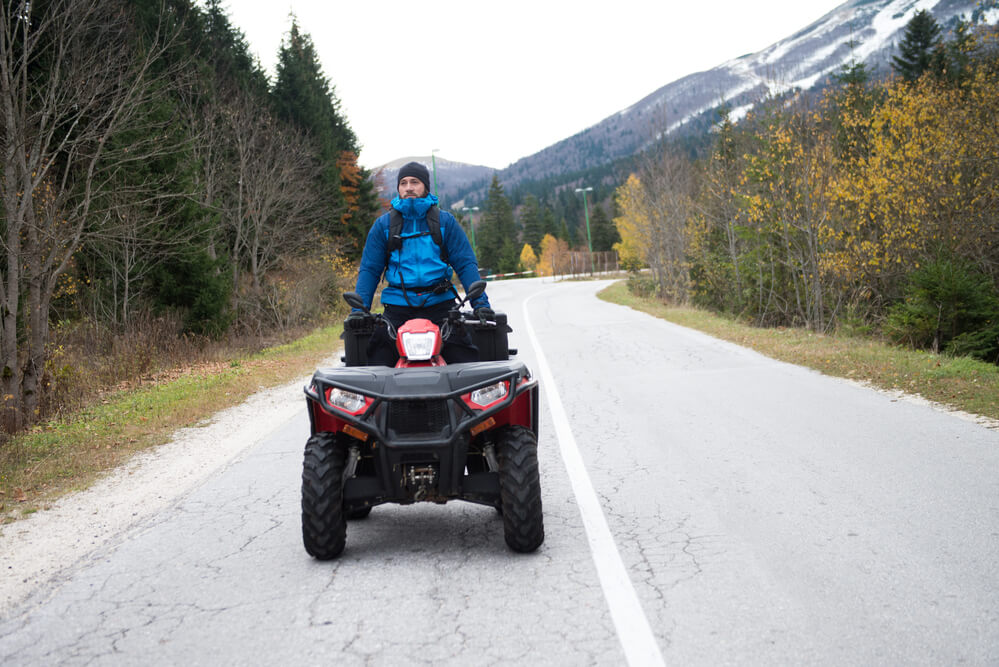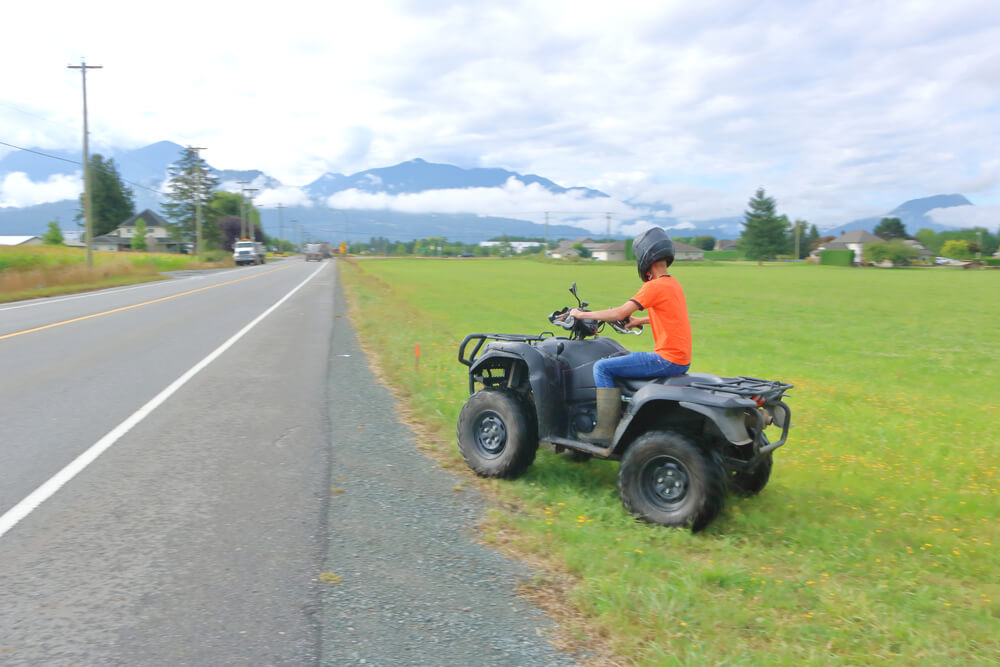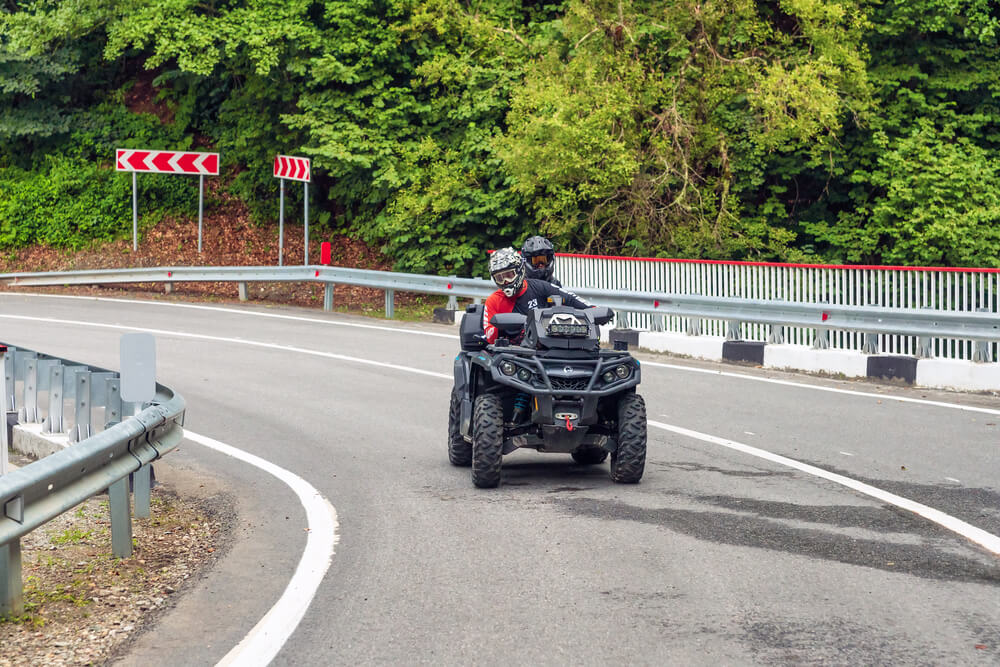Riding an all-terrain vehicle (ATV) on the road can be an exhilarating experience, offering both excitement and convenience for riders. However, before venturing onto public roads, you’ll need to familiarize yourself with the regulations and safety precautions specific to your area.
Laws regarding ATV road usage vary not only by state but also by city, making it essential to stay informed and comply with local requirements.
When considering riding an ATV on the road, it’s also crucial to understand the vehicle’s capabilities and limitations, as well as the necessary maintenance practices to ensure your safety on the road.
Familiarizing yourself with common challenges faced by ATV riders on public roads can help prepare you for a more enjoyable experience while also minimizing potential risks.
Moreover, developing proper road-riding skills will significantly enhance your overall confidence and proficiency when out on the street.
Key Takeaways
- Familiarize yourself with local regulations and safety precautions for riding an ATV on public roads
- Understand your ATV’s capabilities and maintenance requirements for optimal safety and performance
- Develop proper road-riding skills and recognize potential challenges to improve your overall ATV riding experience on public roads
Riding an ATV on the Road

When it comes to riding an ATV on public roads, it’s essential to understand the laws and regulations in your specific area. Laws governing ATV use on roads vary from state to state, so familiarize yourself with your local regulations before embarking on a ride.
ATVs are designed primarily for off-road use, which means they can be challenging to maneuver on paved surfaces. For this reason, some roads might have restrictions or prohibitions on ATV usage.
Riding on public roads without proper knowledge of the law can result in fines, license suspension, or worse, accidents.
Federal ATV laws also play a crucial role in governing the use of ATVs on public roads. Understanding these laws can help you avoid potential legal consequences. It’s also crucial to be aware of any state-specific ATV laws to ensure a safe and legal ride.
Safety is another critical factor to consider when riding an ATV on the road. Since ATVs aren’t designed for paved surfaces, handling them on roads can be a challenge.
Always wear appropriate safety gear, such as helmets, gloves, and protective clothing, to minimize the risks associated with riding an ATV on public roads.
In summary, being knowledgeable about ATV laws and regulations, taking safety precautions, and understanding the limitations of your vehicle will help you enjoy a safe and legal ATV ride on the roads.
Remember, always follow the rules and prioritize your safety as well as the safety of others on the road.
Legal Aspects of Road Riding
When it comes to riding an ATV on the road, there are several legal aspects to consider. It is essential to understand the permits and licenses, roadworthiness requirements, and insurance needs before you hit the pavement.
Permits and Licenses
Each state has its own rules and regulations regarding ATV use on public roads. Before riding, check the laws in your area and obtain any necessary permits or licenses.
Having a valid driver’s license is often a requirement, and additional endorsements might be needed depending on your state.
Road Worthiness Requirements
To ensure your ATV is legally allowed on public roads, it must meet specific roadworthiness requirements.
These may include:
- Tires: Your ATV should have rubber tires suitable for use on pavement.
- Lights and signals: Install working headlights, taillights, turn signals, and brake lights.
- Mirrors: A rearview mirror is often required to monitor traffic behind you.
It is important to review your state’s roadworthiness requirements before venturing out on the road.
Insurance Needs
Just like other vehicles, ATVs need insurance coverage when operated on public roads. Obtain at least the minimum required liability coverage, but consider adding extra protection through comprehensive and collision coverage.
Consult your state’s insurance regulations to ensure you have the proper coverage in place.
By familiarizing yourself with the legal aspects of road riding, you can ensure a safe and enjoyable experience while abiding by the law.
Safety Precautions

Protective Gear
When riding an ATV on the road, it’s crucial to ensure your safety by wearing the appropriate protective gear. Always wear a helmet that is certified by the U.S. Department of Transportation (DOT) and/or the Snell Memorial Foundation (Snell) to adequately protect your head in case of an accident.
Additionally, don’t forget to wear goggles, gloves, long pants, a long-sleeved shirt, and over-the-ankle boots to protect your eyes, hands, and body from debris and potential injury.
Maintaining Visibility
Maintaining visibility is essential to ensuring your safety and the safety of others on the road. Be mindful of your surroundings and anticipate potential hazards.
Keep your headlights on at all times to make it easier for other drivers to see you, even during daylight hours.
Use turn signals or proper hand signals to communicate your intentions to others on the road. It’s also important to position yourself and your ATV in a manner that allows for maximum visibility — especially when approaching intersections or making turns.
Right of Way
Understanding and respecting the right of way is vital for avoiding accidents. Always yield to pedestrians, bicyclists, and other vehicles as required by traffic laws. Be cautious when approaching intersections and crossroads; slow down and look both ways before proceeding.
It’s crucial to familiarize yourself with the specific ATV rules and regulations in your state, as they may vary. Riding an ATV on public roads is often prohibited, except to cross where permitted by law.
Knowing and following the rules will help ensure a safer riding experience for you and others on the road.
Remember to keep these safety precautions in mind when operating an ATV on the road to ensure a safer and more enjoyable ride.
ATV Maintenance
When riding an ATV on the road, it is crucial to ensure your vehicle is well-maintained for a safe and enjoyable experience.
In this section, we will cover essential maintenance checks you need to perform regularly, including brake checks, tire checks, and engine monitoring.
Brake Checks
Regularly inspecting your ATV’s braking system is critical to ensure your safety on the road.
Focus on the following aspects:
- Brake pads: Visually inspect the brake pads for signs of wear and replace them if they appear thin or have any cracks.
- Brake fluid: Check the brake fluid levels and top off if necessary. Also, replace the fluid at least once a year to maintain optimal braking performance.
- Brake lines and hoses: Inspect for any leaks, cracks, or damage. Replace any damaged parts immediately.
Tire Checks
Your ATV’s tires play an essential role in maintaining traction and stability on the road. Be mindful of the following while examining your tires:
- Tread depth: Ensure sufficient tread depth for optimal grip. Replace tires with worn-out or uneven tread.
- Tire pressure: Maintain proper tire pressure as per the manufacturer’s recommendation, usually around six to seven pounds depending on your preference.
- Tire damage: Look for dents on rims, cracks, and bubbles that could indicate potential failures. Address any damage before hitting the road.
Engine Monitoring
Regular engine monitoring will ensure the smooth functioning of your ATV on the road.
Focus on these areas:
- Oil change: Regularly change your ATV’s engine oil according to the manufacturer’s recommendations. Select the appropriate grade and type of oil for your specific model.
- Coolant levels: Keep an eye on the coolant levels in your ATV’s engine and top off if necessary. Replace the coolant at the recommended intervals for optimal performance.
- Air filter: Clean or replace the air filter periodically to ensure efficient air intake and reduce the risk of engine damage.
By incorporating these maintenance practices into your routine, you can extend your ATV’s life, enhance its performance, and guarantee a safe and enjoyable ride on the road.
Common Road Challenges for ATV Riders

Riding an ATV on the road can present several challenges that you may not encounter when off-roading.
In this section, we will discuss some of the most common challenges and provide tips to help you safely navigate them.
Handling Traffic
One of the most significant differences between riding an ATV off-road and on the road is dealing with traffic. You must be extra cautious when sharing the road with cars, trucks, and other vehicles.
Remember to:
- Maintain a safe distance from other vehicles
- Keep your speed in check and obey posted speed limits
- Stay visible by using lights and wearing bright clothing
- Be aware of blind spots and avoid lingering in them
Navigating Intersections
Intersections can be particularly tricky for ATV riders.
To safely navigate intersections, you should:
- Always use your turn signals to indicate your intentions
- Slow down when approaching intersections and look both ways
- Make eye contact with other drivers when possible
- Give yourself extra time to cross busy intersections
Off-Road to On-Road Transitions
Transitioning from off-road to on-road riding can be challenging, especially if you are not familiar with the laws and regulations in your area.
To make this transition smoother, consider the following tips:
- Know the local laws regarding ATV use on public roads
- Ensure that your ATV is equipped with the necessary safety equipment, such as lights, mirrors, and a horn
- Familiarize yourself with on-road signage and traffic rules
- Practice your on-road riding skills in a safe and controlled environment before venturing onto busier roads
Road Riding Skills

While riding an ATV on the road is generally not recommended, there are situations where it might be necessary.
In these cases, developing specific road riding skills is crucial for your safety. This section will cover essential techniques such as cornering, balancing, and overcoming obstacles.
Cornering
When cornering on an ATV, it’s essential to maintain control and stability.
To do this, you should:
- Approach the corner at a controlled speed.
- Shift your body weight to the inside of the turn, placing your inside foot forward.
- Use both brakes to slow down if necessary, but gradually release them as you enter the turn.
- Steer the ATV through the turn, keeping a firm grip on the handlebars.
- Accelerate gradually as you exit the corner, maintaining a smooth, controlled motion.
Remember that road surfaces can be slippery, so adjust your speed and technique accordingly.
Balancing
Proper balancing on an ATV is crucial for smooth and safe riding on the road:
- Seated: Maintain a comfortable seating position, with both hands on the handlebars and both feet on the footrests. Keep your knees slightly bent and your back straight.
- Standing: In certain situations, you may need to stand while riding, such as when overcoming obstacles. Keep your knees and elbows slightly bent, maintaining a relaxed grip on the handlebars.
By adjusting your body position, you can counterbalance the ATV’s movements and maintain stability.
Overcoming Obstacles
While on the road, you may encounter various obstacles, such as potholes or debris.
To safely overcome these challenges, follow these steps:
- Scan the road ahead and identify potential hazards early.
- When approaching an obstacle, reduce your speed and prepare to adjust your body position.
- For smaller obstacles, you can either steer around them or lift your body weight slightly as you ride over, allowing the ATV to absorb the impact.
- For larger obstacles, standing up on the footrests and using your legs as shock absorbers can help you maintain control and stability.
By practicing these road riding skills, you can ensure a safer and more enjoyable experience when operating an ATV on roads.
Benefits of Road Riding

Riding an ATV on the road has several advantages that can enhance your overall experience. First and foremost, it provides a convenient way to access local amenities, such as gas stations, restaurants, and accommodation.
This makes your ATV outings more enjoyable and practical, as you can easily attend to your needs during the trip.
Another benefit of road riding is the potential for improved mental health. Riding on the streets can act as stress relief, allowing you to break away from routine and explore new environments.
The adrenaline released during ATV rides can uplift your mood and make you feel rejuvenated.
In addition to mental health benefits, road riding with your ATV can lead to physical health improvements. The act of steering, accelerating, and braking engages various muscle groups, contributing to your overall fitness and well-being.
Lastly, utilizing an ATV on the road opens up opportunities for exploring undiscovered areas. As a versatile mode of transportation, ATVs offer the unique ability to switch between paved roads and off-road trails seamlessly.
Adventurous souls can use their ATVs to reach new hiking or biking spots that might otherwise be inaccessible.
Remember to always follow local regulations and guidelines for road riding, as laws regarding ATV use on the streets vary by location. By respecting the rules and considering the benefits mentioned above, you can fully enjoy the advantages of road riding with your ATV.
Potential Drawbacks of Road Riding
Riding an ATV on the road can be an exciting experience, but it’s crucial to be aware of the potential drawbacks that may arise from road riding. Understanding these risks will help you make informed decisions and ensure a safer ride.
First and foremost, ATVs are designed specifically for off-road use. When you ride these vehicles on public roadways, you’re more likely to encounter situations for which the ATV wasn’t designed, potentially leading to accidents.
In fact, riding ATVs on public roadways is considered one of the most significant risk factors for serious injury and death.
Another drawback of riding ATVs on paved roads is their instability. ATVs are built for traversing uneven terrain, and their low-pressure tires are not suited for the hard, flat surfaces of paved roads.
As a result, riding on paved roads can make the ATV difficult to control and more likely to roll over, putting both the driver and other road users at risk.
Furthermore, many states have laws restricting or prohibiting the use of ATVs on public roads. Disregarding these laws may result in fines, penalties, or even accidents. It’s essential to familiarize yourself with the regulations in your area.
Lastly, it is important to consider the potential impact on local communities. Allowing ATVs on roads can generate noise, pollution, and traffic concerns for those living and working nearby. In some cases, this can lead to conflicts between ATV riders and community members.
Being aware of these drawbacks may help you make more responsible choices when it comes to riding your ATV on the road.
Always prioritize safety and adhere to local laws and regulations to ensure an enjoyable and secure riding experience.
Conclusion
Riding an ATV on the road can be a thrilling experience, but it’s important to weigh the pros and cons before venturing onto public streets. While some states allow limited ATV use on roads, others have strict restrictions in place to ensure the safety of both ATV riders and other motorists.
To ensure your safety and prevent accidents, it’s crucial to follow local regulations and be aware of ATV safety tips while riding on roads. Familiarize yourself with your ATV’s handling, wear protective gear such as a helmet, and avoid carrying passengers unless your ATV is designed to do so.
Keep in mind that the consequences of riding your ATV on the road depend on the specific laws in your area. Penalties can range from fines to vehicle impounding or even arrest in some cases.
Riding an ATV on the road requires careful consideration of the potential risks and benefits. By adhering to the guidelines and best practices, you can enjoy the ride while minimizing danger to yourself and others around you. Remember to always prioritize safety and abide by the laws in your region.
Frequently Asked Questions
What are the requirements for making an ATV street legal?
To make your ATV street legal, it typically needs to be equipped with certain items such as headlights, taillights, turn signals, mirrors, and a horn. The ATV may also need to have a valid license plate, registration, and insurance. Keep in mind that these requirements vary by state, so it’s essential to check your local laws.
Is a special license needed to drive an ATV on public roads?
In some states, a special license or endorsement might be required to operate an ATV on public roads. Requirements vary, and some states may accept a standard driver’s license, while others might need additional ATV-specific education or testing.
Be sure to check your state’s regulations to determine the necessary licensing requirements.
Do ATV laws vary by state?
Yes, ATV laws significantly vary by state. Each state has its own specific regulations for ATVs, including equipment requirements, age restrictions, and allowed roadways. It’s crucial always to be familiar with the local laws when riding to ensure you comply with all requirements and stay safe.
Are there age restrictions for driving an ATV on the road?
Age restrictions for operating an ATV on public roads also vary by state. Some states have minimum age requirements, while others impose guidelines based on the rider’s experience or even require parental supervision. To find the age restrictions in your state, consult your state’s ATV laws.
What safety equipment is mandatory for ATVs on public roads?
ATVs on public roads typically require essential safety equipment, such as headlights, taillights, turn signals, mirrors, and a horn. Some states also require riders to wear a helmet and protective eyewear. As regulations differ among states, it’s crucial to check your state’s specific requirements to ensure you adhere to all safety guidelines.
Can ATVs be ridden in residential neighborhoods legally?
The legality of riding ATVs in residential areas depends on your local and state laws. In some places, ATVs might be allowed only for specific purposes, such as crossing a street or during specific hours. It’s essential to review your state and local regulations before riding an ATV in a residential neighborhood or any public road.














